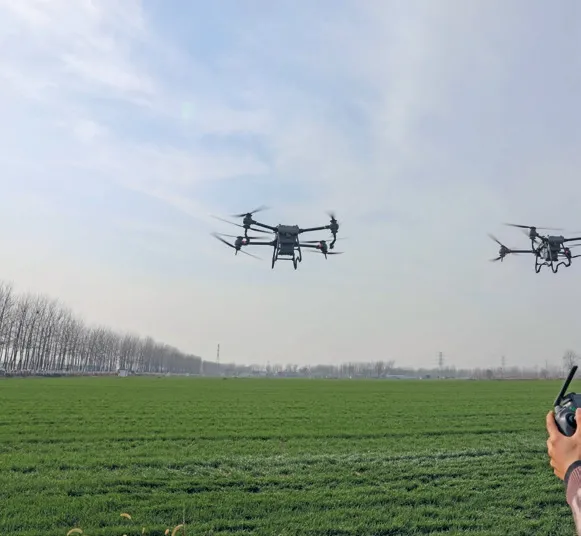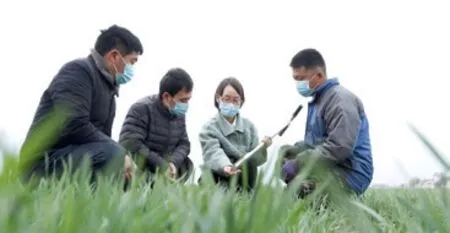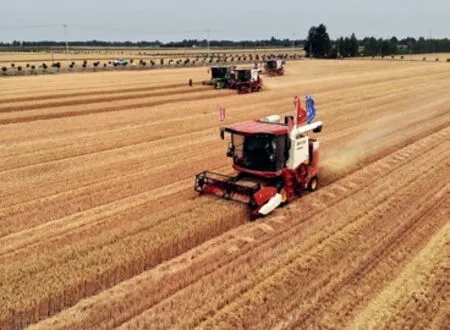HARD-WON HARVEST
2022-07-28ChinasummergrainoutputhitsnewhighByWangHairong
China’s summer grain output hits new high By Wang Hairong

When describing his mood swings over the past few months, Zhao Menghui, a farmer in Xingtai,Hebei Province, compared them to a roller coaster ride through worry, anxiety, relief and, eventually, joy.
Zhao manages about 55 hectares of grain field. Last summer, his fields were flooded, leading to a corn crop failure. Then in October, after 10 days of continuous rain,the fields were soaked, making him very anxious because he was about to miss the right sowing time for his winter wheat.
Just as he was about to give up, agrotechnicians sent by the local government came to his rescue, guiding him in draining and drying the fields. After the seeds were sown in November,he worried they would freeze over after sprouting. Again, the technicians advised him about the best course of action. This spring, Zhao received a government subsidy that covered the cost of pesticides, fungicides and plant growth regulators. He diligently irrigated the field and applied fertilizers and pesticides in strict accordance with standard practices. As the wheat grew taller and stronger day by day, he was filled with relief.
In mid-June, the wheat was harvested, and Zhao was happy about the high yield. He said his wheat is of the high-gluten kind, which can fetch a good price, and after deducting all the costs, he could earn a total net profit of 479,700 yuan ($70,995).
“This has been the most profitable year to date for me. I’m very happy,”he said at a press conference hosted by the Ministry of Agriculture and Rural Affairs (MARA) in Beijing on July 14. On the same day, the National Bureau of Statistics (NBS) announced that China’s summer grain harvest has grown 1 percent from last year.
Enhancing grain security
The harvest is reassuring for the country. “This year’s summer grain harvest marks a further increase on top of a record-high output. It is both exciting and encouraging,” Pan Wenbo,Director of the MARA’s Department of Crop Production, said at the press conference.
Summer grains account for approximately one fourth of the annual output in China, while wheat harvested in summer accounts for approximately 40 percent of grains for human consumption, according to Pan.
Summer grains mainly include wheat, barley, oats and buckwheat, as well as beans and tubers such as potatoes and sweet potatoes, according to the NBS. This year, their output totaled 147.39 million tons, 1.43 million tons more than last year; in particular, the output of wheat reached 135.76 million tons, up 1 percent year on year.
Currently, China is basically selfsufficient in staple grains, including rice and wheat, while importing other agricultural products such as soybeans.The summer grain harvest is not only important for the country but also for global food security.
This year, stable food production is particularly important as the COVID-19 pandemic and the conflict in Ukraine, a major exporter of corn and wheat, are undermining global grain security.
World hunger has increased since the outbreak of COVID-19. Some 828 million people suffered from hunger in 2021, an increase of 46 million from 2020, and 150 million from 2019, according to the recently published 2022 edition of the State of Food Security and Nutrition in the World, an annual report jointly prepared by the UN Food and Agriculture Organization (FAO),together with the World Food Program(WFP), the World Health Organization and other related organizations.
The FAO estimated that the conflict in Ukraine could lead to an increase of 13 million more chronically undernourished people this year and 17 million more by the end of 2023.
On July 15, the heads of the FAO,International Monetary Fund, World Bank Group, WFP and World Trade Organization issued a joint statement calling for urgent action to address the global food security crisis.
In their statement, they noted an increase in the number of acutely foodinsecure people and the doubling of fertilizer prices over the last 12 months,and they also pointed out that around 25 countries had reacted to higher food prices by adopting export restrictions affecting over 8 percent of global food trade.
They called for the provision of immediate support to the vulnerable, facilitating trade and international supply of food, boosting production and investing in climate-resilient agriculture.
Overcoming adversity
China has stepped up support for food production, increasing the minimum purchase price for wheat to stabilize farmers’ expectations and holding officials responsible for food insecurity,said Wang Guirong, director of the NBS’ rural department.
This year’s summer grain output has increased despite severe challenges such as last autumn’s floods in major production areas during the winter wheat sowing season, COVID-19 flareups, and surging prices of agricultural production materials.
Because of last autumn’s floods,nearly one third of winter wheat fields could not be sown in time, Pan said.
In China, winter wheat grows mainly in Henan, Shandong, Hebei,Shanxi and Shaanxi provinces, where the crop is usually sown before the end of October, and after surviving the region’s relatively mild winter, it ripens in early summer. Winter wheat sown too late will lead to yield reduction.
In colder areas such as Heilongjiang Province and the northern part of Xinjiang Uygur Autonomous Region,wheat is sown in spring because it cannot survive the harsh winter. Some varieties of spring wheat can ripen in summer and be counted as summer grains, while those that ripen in autumn are categorized as autumn grains.
Nonetheless, harvest has been achieved this summer because “people worked especially hard, and weather conditions also helped,” Pan said. In particular, he attributed the good harvest to an increase in sowing area and unit yield.
According to him, the total sowing area of summer gains this year reached 26.53 million hectares, 0.3 percent more than last year. Although the winter wheat sowing area was reduced by 67,300 hectares because of autumn floods, the sowing area of spring wheat harvested in summer was expanded by 118,000 hectares, or 23 percent.Large stretches of cotton fields in Xinjiang, previously fallowed fields in Gansu Province, and fields growing other crops in Ningxia Hui Autonomous Region were converted to grow spring wheat harvested in summer. Moreover,in south China, the growing areas of beans and tubers also expanded.
Pan said the expansion in the sowing area of spring wheat harvested in summer contributed 43 percent of the increase in summer grain output.
He added that 64 percent of the growth in summer grain output came from an increase in unit yield, an average year-on-year rise of 34.5 kg per hectare.
Favorable weather conditions also contributed to the harvest. Wang said a quick temperature rebound in early spring, and fewer-than-usual disasters such as “the late spring cold” and drought had helped crop growth, while high soil moisture and large temperature differences between morning and evening in summer were favorable for grain filling.

A meteorological worker and farmers check soil moisture in a wheat field in Xingtai, Hebei Province,on March 17
Strength of technology
Science and technology have played an important role in ensuring this year’s summer grain harvest, said Zhao Guangcai, a researcher with the Institute of Crop Sciences at the Chinese Academy of Agricultural Sciences.
Farmers needed guidance on how to sow the seeds at a time later than the optimal sowing season, and how to then manage their fields to boost growth, he added.
Zhao Guangcai said agrotechnicians gave them important suggestions regarding late-planted crops, such as choosing quick-ripening and high-yield varieties, sowing more seeds, sowing in shallow soil and applying more fertilizer.
He recalled how during his visit to a wheat field in Hebei last year, he had met some farmers who wanted to give up entirely because they saw no seedlings of late-planted wheat sprouting after having waited for a reasonable period. “We dug up some seeds from the soil and found they had already germinated, so we suggested farmers wait patiently and apply more fertilizer and water after the seedlings emerged,” he said. “Eventually, the yield exceeded 6,000 kg per hectare.”
Pan said this spring, hundreds of MARA experts were dispatched to rural areas to provide technical assistance, while experts from local agricultural and rural affairs departments also paid 624,000 visits to villages to help farmers.
“During last autumn’s sowing season, the ground was wet, rendering crops more prone to disease,” Pan said.During their autumn sowing, more than 99 percent of the main production areas dressed the seeds with chemicals as a precaution, while emergency teams were dispatched as soon as spring started to prevent and control crop diseases, he said.
Moreover, modern agricultural devices have been installed in many fields to carry out automatic real-time monitoring and early warning of crop diseases and pests.
“Our equipment, developed in collaboration with experts from Northwest A&F University, has been deployed across major wheat production areas,”Huang Weili, an executive of Xi’an Huang Bioengineering Co. Ltd. in Shaanxi, told.
The devices, powered by solar panels, have sensors that collect environmental data and can detect plant diseases in time to alert farmers via their smartphones so they can spray fungicides in time, Huang explained.
Due to these efforts, this year, the area of fields infected by wheat stripe rust and scab went down 91 and 40 percent, respectively, from last year,and the proportion of affected wheat crops was kept below 0.2 percent, Pan said.
Risk management
The COVID-19 pandemic has led to several uncertainties in summer grain production. As wheat harvest season approached, new local infections emerged in several places, including the major wheat-producing provinces of Henan, Hebei and Anhui.
“There was widespread concern that the situation would lead to agricultural machinery operators being less willing to engage in cross-regional operations, which might in turn lead to a shortage of wheat harvesters in some areas and even missing the appropriate harvest time, causing grain losses,”said Wang Jiayun, Deputy Director of MARA’s Department of Agricultural Mechanization.

Harvesters reap wheat in a field in Pingdu, Shandong Province, on June 12
The ministry took measures that ensured harvesters were matched with households in advance so that their fields could be harvested in time. It also coordinated with transportation, public health and other related departments to facilitate the travel of harvesters and their operators across regions.
Wang Jiayun said from late May to late June, more than 650,000 combine harvesters took part in wheat harvesting, with 250,000 of them engaging in cross-regional operations.
To further dampen the adverse impact of the pandemic, more than 5,400 emergency service teams were formed to help farmers, and hotlines were set up to respond to their requests, Pan said. If farmers were quarantined due to COVID-19 infection and could not harvest the wheat, the teams could do it for them.
Several towns in Changge, Henan, were hit by COVID-19 resurgences during wheat harvest season and farmers were required to stay home. Volunteer teams were formed, with team members harvesting wheat and delivering it to farmers’ homes.
In addition, this year, MARA also organized major wheat production provinces to sign cooperative agreements on agricultural machinery for sowing and harvesting, so that they can provide emergency support to each other under extreme circumstances, such as droughts and floods, as well as in the event of public health emergencies. MARA’s leaders also oversaw the harvest in major wheat-producing provinces.
Now, with summer grains already harvested, MARA has dispatched working groups to lead undertakings in flood and drought prevention and control to ensure an autumn harvest. Pan said that July to September is the key period for the growth of autumn grains, as well as a period susceptible to droughts and floods; so winning the race for an autumn grain harvest remains a tough task.
Autumn grains account for more than three quarters of the total. This year, the acreage of autumn grains has increased slightly, and the growth of autumn grains is normal, Pan said.
The summer harvest has boosted farmer confidence in the autumn harvest. Zhao Menghui said after the wheat had all been gathered, his fields were interplanted with soybean and corn. “There has been plenty of rain this year, and soybeans and corn are thriving. I believe we can have a bumper harvest this autumn,” he said. BR
